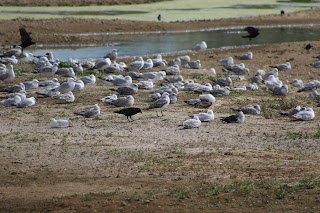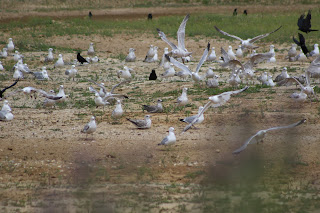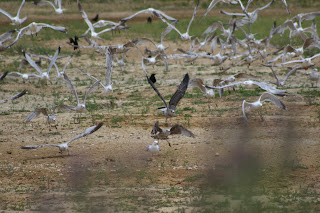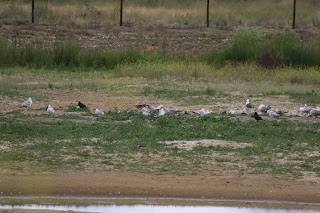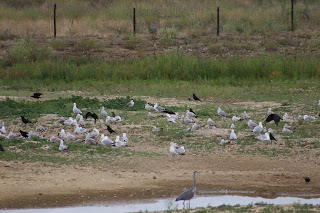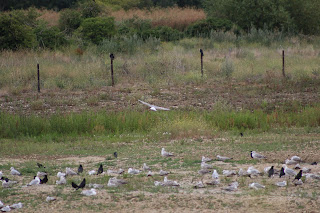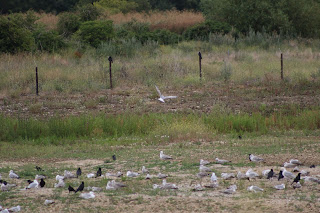Scanning through the gull flock in the summer is not for everyone, but the smaller number of Herring Gulls compared to the winter does mean that you're more likely to spot any scarcer gulls that may be trying to hide and go unnoticed. On the 2nd I found a lovely 2cy Yellow-legged Gull (Larus michahellis) from the hide on Phase 1 Wet Grassland. This was my third YLG of the year and I was rather pleased. It was very inactive and basically did nothing for a whole hour whilst I watched it until eventually a Common Buzzard flew past and put all the gulls up. With Phase 1 Wet Grassland not even having any gulls left on it I heading round to the North Lake hide to scan the gulls out on the main island. Rather quickly I relocated the 2cy YLG. Unfortunately it was even more inactive here than back on Phase 1 Wet Grassland! Before I headed home I went back to look out over Phase 1 Wet Grassland again knowing that some gulls would have resettled since the earlier Buzzard chaos. I was instantly drawn to a fresh juvenile gull sat with its head tucked into its back. I've been looking forward to the arrival of the juvenile YLGs. However, this particular bird turned out to be a juvenile Lesser Black-backed Gull. Perhaps bred somewhere relatively local on the roof of a building?
The 9th turned out to be even better in terms of gulls. The same 2cy YLG was almost in the exact same spot on the main island of the North Lake as the previous week. But when I got to Phase 1 Wet Grassland I was absolutely delighted to spot a Caspian Gull. But this was not just any Caspian Gull. It was a 3rd cycle bird (the oldest Caspian Gull plumage I have seen) and it was the same bird that had been first found here by Arjun in October 2020 (my first ever!). It hadn't been seen since April so it was great to see how its plumage has developed but also good that it was still recognisable as the same individual (no ring on this bird so purely going on plumage and structural characteristics). Whilst watching the Caspian Gull I had also noticed an interesting gull with a darker mantle than the surrounding Herring Gulls. Once the Caspian Gull had walked into a ditch and out of sight I shifted my full attention onto the dark-mantled bird. Its stocky build and plumage made it a good candidate for a 3rd cycle YLG (another plumage tick for me). However, before I put the news out I was careful to study the bird as I am aware of the potential risk of Herring x LBBG hybrids. I'm still not fully confident with ruling out these hybrids at times but once I saw this bird fly after watching it for 40 minutes I decided I was happy with 3rd cycle YLG and put the news out on the appropriate local WhatsApp groups. Despite this, I still had to check with Dante when reviewing the photos purely to triple check that it was not a hybrid (I've been fooled too many times before!). Later the 3rd cycle bird was on the main island of the North Lake. There was also a fresh juvenile Herring Gull - I tried my best to morph it into a juvenile YLG but the wait continues. Rich Bonser is also still waiting for his first juvenile YLG on the Thames this year.
 |
| Juvenile Little Ringed Plover |
Starlings above and below
 |
| I bumped into this crow head on the path leading to 100 Acre |
2cy Yellow-legged Gull below:
Juvenile Lesser Black-backed Gull below
3rd cycle Caspian Gull below:
3rd cycle Yellow-legged Gull below:
Juvenile Herring Gull below:
Non-bird highlights:
My first Willow Emerald Damselfly of the year above and below
 |
| My first Jersey Tiger Moth of the year |
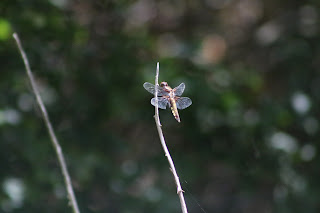 |
| My first ever Broad-bodied Chaser (I'm sure I've seen these in the past when I was younger before I knew what they were) |
Ebird list from the 2nd here and from the 9th here.


